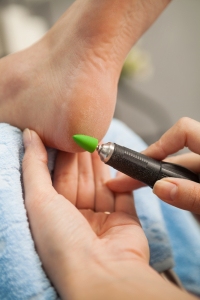Calluses (thanks to www.touchabletoes.com for this image) and corns are waxy appearing skin surface changes that have developed because of increased friction and pressures in areas where skin is sandwiched between bone and outside pressure from tight shoes etc.
A typical location for a corn would be at the outside foot in a woman wearing heal high shoes. The skin that is directly affected will become thicker, particularly the keratin, and this causes painful waxy looking lesions,called calluses.
The center of these dry up and become like biological “thumb tacks” called foot corns
that irritate the underlying skin nerve endings. No wonder that the patient has pain with every step she takes. Here is a link to a picture of a corn.
Women are affected with corns and calluses 2 to 3 times more often than men (Ref. 6, p. 1039).
Corns and calluses
____________________________________________________________________
Callus : waxy thickened skin, mostly across the bony forefoot (over the metatarsal heads); skin markings are preserved; on feet of persons who do not wear shoes
Corn : dry, cone shaped translucent hard skin; skin markings stop at edge of this lesion; in its moist form can be white, soft, then often located between the web spaces of toes; usually in women who wear too narrow shoes and/or high heels
____________________________________________________________________
Signs and symptoms
As explained above, most of the time corns and calluses appear on feet where pressure on the skin is largest due to the body weight. However, some people with bone deformities may also have calluses elsewhere on the body (knees, elbows), particularly if there are additional occupational stresses put on the skin.
Diagnostic test
In the foot area it is important for the physician to make a distinction between plantar warts, corns and calluses.
With calluses the skin markings are preserved, but with plantar warts they are interrupted. Also, when the physician or podiatrist shaves the surface off the lesion, in the case of a callus and corn there is no bleeding, but with a plantar wart there are points of bleeding from the wart vessels. This is an important distinction that physicians use to diagnose the various conditions.
Calluses treatment
The physician or podiatrist will shave the corns and calluses down to the normal level of the skin. This is done with a sharp surgical blade that is held parallel to the skin surface. In a case where the condition has been neglected for several years, the health care provider may send the patient home with the following advice: soak the foot in warm water with potassium permanganate (1:4,000 solution), to soften up the corns and calluses.
The softened skin can be removed with a pumice stone or sand paper. For the next few days apply salicylic acid, lactic acid, or a combination of both as a cream onto the callus and corn. This can be done overnight and covered with a bandaid. These preparations are available over the counter in the pharmacy. The following morning always remove the macerated soft skin. After several days or 1 or 2 weeks of this, see the health care professional again to have it checked and cleaned up with the scalpel, which will bring back the normal skin in this area.
From here onward it is important that the normal skin is protected from excessive pressure by applying sheep’s skin or foam pieces where otherwise there would be pressure. Shoes need to be widened in a shoe repair shop. If this is not possible, you can go to a specialty shoe store to have your foot sized and have a properly fitted shoe made. High heels for ladies should be reserved for only special occasions, but not routinely worn. Fashionable shoes are usually too narrow in the front of the shoe and have too high a heel. This causes calluses, corns and bunions. If the calluses and corns return despite these measure , the health care provider should rethink the situation. There could be an underlying bone lesion that may need some daycare surgery. A referral to an orthopedic surgeon may be required at this point in time.
References:
1. Habif: Clinical Dermatology, 3rd ed.,1996, Mosby-Year Book, Inc.
2. The Merck Manual, 7th edition, by M. H. Beers et al., Whitehouse Station, N.J., 1999. Chapter 117.
3. Cotran: Robbins Pathologic Basis of Disease, 6th ed.,1999, W. B. Saunders Company
4. Noble: Textbook of Primary Care Medicine, 3rd ed., 2001, Mosby, Inc.
5. Rakel: Conn’s Current Therapy 2001, 53rd ed., 2001, W. B. Saunders Company
6. Goroll: Primary Care Medicine, 4th ed., 2000, Lippincott Williams & Wilkins
7. Richard J. Lewis, M.D. at the 42nd Annual St. Paul’s Hosp. CME Conf., Nov.1996, Vancouver/BC
8. Jerry Shapiro, Prof. Dermatol., UBC, at 45th Annual St. Paul’s Hosp. CME Conf., Nov.1999, Vancouver/BC
9. D Seager Int J Cosmet Surg Vol 6, No. 1, 1998: 27-31.
10. Townsend: Sabiston Textbook of Surgery, 16th ed.,2000, W. B. Saunders Company
11. Ferri: Ferri’s Clinical Advisor: Instant Diagnosis and Treatment, 2004 ed., Copyright © 2004 Mosby, Inc.
12. Rakel: Conn’s Current Therapy 2004, 56th ed., Copyright © 2004 Elsevier







